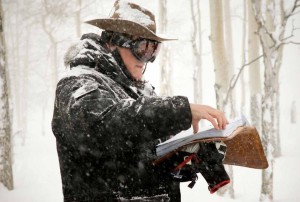
Hateful Eight contains the usual big dollop of the brutal but stylized violence the director is known for, and the screenplay is laced with his usual mordant wicked wit.
But in several ways Hateful Eight, distributed by the The Weinstein Company, is a unique addition to Tarantino’s body of work. It’s another Western, like Django, but its plot resembles an Agatha Christie mystery. And it has been stunningly shot in a retro 70mm format that in movie theaters is being projected across a very wide screen, looking like no film Hollywood has made for nearly 50 years.
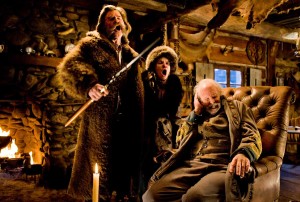
“I was very excited with the idea of doing a mystery, I had never done one before,” said Tarantino. He acknowledged being influenced by Christie, particularly by one of her best-known whodunits, And Then There Were None, where guests invited to a house for a weekend start dying one by one. The novel has been turned into a movie a number of times, most recently under the title of Ten Little Indians in 1965, which is a favorite of the director. “What I like that I’ve done in Hateful Eight is letting the mystery unfold mainly in the second half, so there’s lots of time for the building up of the characters,” he declared.
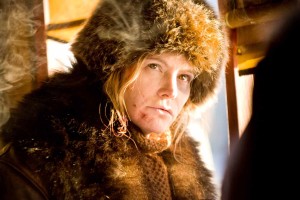 From a production standpoint, Hateful Eight stands out for how it was shot. The movie employs the Ultra Panavision 70 technique with antique 65mm Panavision lenses mounted on a film camera. These are the exact same lenses that were last used 48 years ago on Khartoum and before that on Ben Hur and Mutiny on the Bounty starring Marlon Brando. Moreover Hateful Eight is being released in anamorphic 70mm, which translates into a super wide screen with a 2.75:1 aspect ratio.
From a production standpoint, Hateful Eight stands out for how it was shot. The movie employs the Ultra Panavision 70 technique with antique 65mm Panavision lenses mounted on a film camera. These are the exact same lenses that were last used 48 years ago on Khartoum and before that on Ben Hur and Mutiny on the Bounty starring Marlon Brando. Moreover Hateful Eight is being released in anamorphic 70mm, which translates into a super wide screen with a 2.75:1 aspect ratio.
“I knew I wanted to do the movie in 70mm and even wrote it into the script,” said Tarantino. “My cinematographer Robert Richardson went down to Panavision to explore what equipment might be available to pull this off. He discovered these amazing lenses while rummaging around.” Panavision found a set of 15 of these lenses and were willing to adapt them for use in modern cameras. “Bob and Gregor Tavenner, his 1st assistant cameraman, took them up into the snow to try them out because there was some concern they would freeze or lock up but they ended up working beautifully,” he noted.
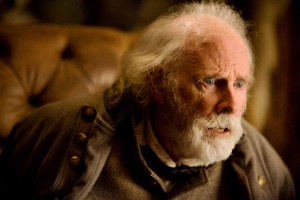 There are many gorgeous landscape shots in the snowy mountains, but the movie plays out largely in Minnie’s Haberdashery. “There was some speculation before Hateful Eight came out about what was the point of doing it in 70mm, since most of the movie takes place in a shack,” said the director. “But that’s a misconception. This wide screen format doesn’t have to be used just for visual spectacles and travelogues,” he added. “Capturing this bleak Western landscape, capturing the snow, capturing the beauty of these locations was of course perfect for 70mm. But I believe that these big formats also offer more intimacy. It brings the viewer closer and invades the intimacy of the characters in its bigness.” There are indeed lots of close-ups on different characters, where the screen is filled with just one face, creating visual and dramatic impact.
There are many gorgeous landscape shots in the snowy mountains, but the movie plays out largely in Minnie’s Haberdashery. “There was some speculation before Hateful Eight came out about what was the point of doing it in 70mm, since most of the movie takes place in a shack,” said the director. “But that’s a misconception. This wide screen format doesn’t have to be used just for visual spectacles and travelogues,” he added. “Capturing this bleak Western landscape, capturing the snow, capturing the beauty of these locations was of course perfect for 70mm. But I believe that these big formats also offer more intimacy. It brings the viewer closer and invades the intimacy of the characters in its bigness.” There are indeed lots of close-ups on different characters, where the screen is filled with just one face, creating visual and dramatic impact.
Hateful Eight is the fifth film Tarantino has done with triple-Oscar winner Richardson. “How our relationship works is I do the framing and the composition and I leave the lighting all to him,” said the director. “He does the lighting and the shooting brilliantly and I don’t have anything to add to that conversation. Bob wouldn’t have it any other way. He knows I’m here to do a Quentin Tarantino movie which is why I do my own framing.”
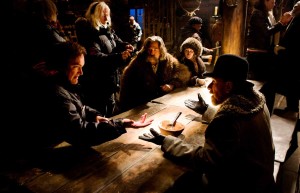 Yohei Taneda, the production designer, came up with look of Minnie’s Haberdashery. It was built on the Schmid Family Ranch on Wilson Mesa near Telluride in Colorado. “We built the cabin twice, on location where both the outside and inside were constructed separately, and later on a set in Los Angeles,” said the director. The interior was stuffed with period items located by set decorator Rosemary Brandenburg.
Yohei Taneda, the production designer, came up with look of Minnie’s Haberdashery. It was built on the Schmid Family Ranch on Wilson Mesa near Telluride in Colorado. “We built the cabin twice, on location where both the outside and inside were constructed separately, and later on a set in Los Angeles,” said the director. The interior was stuffed with period items located by set decorator Rosemary Brandenburg.
The relentless snowstorm that batters the cabin was manufactured, without any CGI. “It was phony snow, and we used big fans to create all the blizzard effects ourselves,” he noted “It would have been impossible to shoot in a real blizzard. We got all the weather we wanted but we couldn’t predict it.” Shooting the interior scenes was done when it was sunny outside. “If it was gray and overcast we’d take advantage of it and shoot outdoors, like the scenes in the stagecoach,” Tarantino explained. “But sometimes two or three weeks would pass before we got the same weather, which didn’t help continuity.”
Once all the needed exterior scenes were filmed, shooting moved to Los Angeles where the interior of Minnie’s Haberdashery was recreated on a set down to the smallest details. Temperatures were kept frigid on the soundstage, and it was oftentimes colder than during the location shoot. This was done so the actors’ breath could be seen.
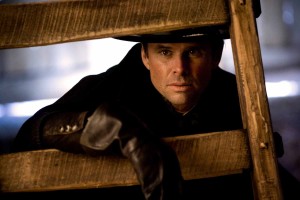 Costume designer Courtney Hoffman, who worked on Django Unchained, is known for careful research and tends to a realistic style. “I decided the clothes should be more like a comic book artist would draw for a character, so thy would pop out,” said Tarantino. “I showed her a bunch of Italian Spaghetti Westerns and turned her into a fan of Carlo Simi, the costume designer who came up with the stylized cowboy clothes for films directed by Sergio Leone like A Fistful of Dollars,” he added.
Costume designer Courtney Hoffman, who worked on Django Unchained, is known for careful research and tends to a realistic style. “I decided the clothes should be more like a comic book artist would draw for a character, so thy would pop out,” said Tarantino. “I showed her a bunch of Italian Spaghetti Westerns and turned her into a fan of Carlo Simi, the costume designer who came up with the stylized cowboy clothes for films directed by Sergio Leone like A Fistful of Dollars,” he added.
The Hateful Eight editor was Fred Raskin, who also cut Django Unchained. He replaced Tarantino’s long-time editor Sally Menke, who died in 2010. “Fred and I were joined at the hip in the editing room, just the way I always worked with Sally,” said the director. “He does an assembly when we’re making the movie, but I don’t feel the true editing starts until I enter the room.”
A big get for Tarantino was legendary and prolific Italian soundtrack composer Enrico Morricone, who did the score. “I had used some of Enrico’s existing music in previous soundtracks, but I never did a film using an entire score by anybody,” said the director. Tarantino’s distinctive soundtracks have featured a pastiche of pop hits, and he has said that he often starts a movie by selecting the music first.
“When we first me in Rome, he said he was excited to meet me, but then he expressed curiosity about why I wanted to explore working with him,” the director recalled. “’You usually take music from others and put it together,’ he said. ‘That’s your method and people seem to like it, so why do want to change?’ I told him I wasn’t sure I wanted to change, but I kept hearing this whisper in my ear that this movie should have a score of its own, and if I was ever to trust someone to do it, I would trust Enrico.”
Tarantino said he still had trepidation about what the composer would come up. “This wasn’t the normal way I worked,” he said. As it turned out Morricone had read the script carefully and instead of a full score he had come up with leitmotifs. “He gave me a suspense motif, or a snow motif, and I was able to decide how to use them which suited me perfectly. In the end I loved the movie’s score.”





